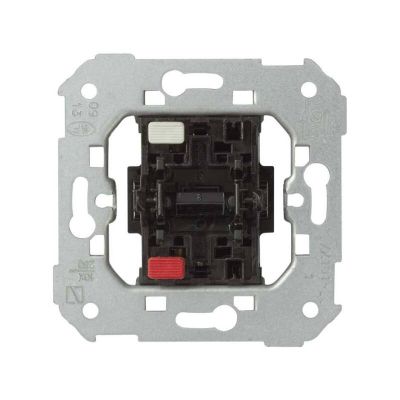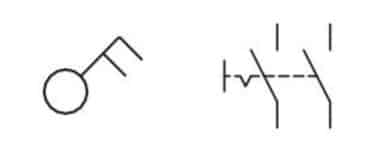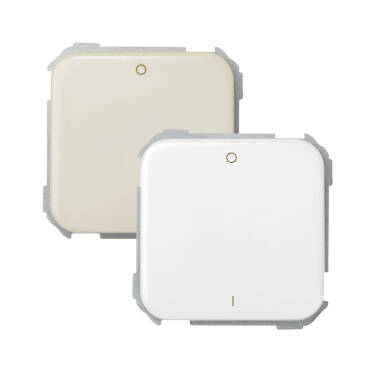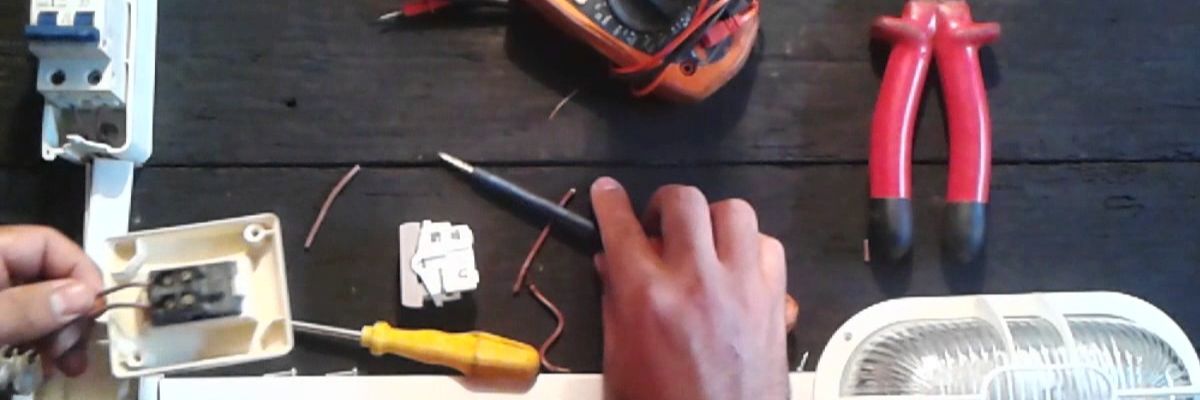Two-pole circuit breakers are an efficient and safe solution for controlling electrical circuits that require a total current cut-off. Their installation, although more complex than that of a single-pole switch, provides advantages in terms of safety and electrical regulations. If you are thinking of upgrading your electrical system, choosing a double-pole switch can be an excellent decision to ensure complete disconnection and avoid electrical hazards.
Let’s see in detail how they work, what are their main uses and some tips to install them safely.
- What is a double-pole circuit breaker?
- What are double-pole circuit breakers used for?
- Symbol of a double-pole switch
- Installation of a double-pole switch
- How to choose the right double-pole switch
- Importance of polarity in two-pole circuit breakers
- Advantages and disadvantages of two-pole switches
- Maintenance and safety in two-pole circuit breakers
- Frequently asked questions about two-pole circuit breakers
What is a double-pole circuit breaker?
A double-pole switch is an electrical mechanism that allows two circuits to be opened or closed simultaneously with a single action. Unlike a single-pole switch, which only interrupts one phase, a double-pole switch cuts both the phase and the neutral, providing greater safety in electrical installations.

They are mainly used in systems where a total current disconnection is required, ensuring that there is no residual voltage in the connected devices. Their use is common in high power equipment or installations where electrical safety is a priority.
Difference between a double-pole and single-pole circuit breaker
The key difference between the two lies in how many poles interrupt the electrical flow. The single-pole switch only interrupts the current flow in one conductor, leaving the neutral connected, while the double-pole switch interrupts both, which minimizes the risk of electrocution or short circuits.
What are double-pole circuit breakers used for?
Bipolar switches are used in various applications, such as:
- High voltage electrical systems: They are used to completely disconnect an electrical device from the power supply.
- High consumption appliances: They are common in electric stoves, water heaters and air conditioners.
- Industrial installations: In heavy machinery where it is vital to completely cut off power to avoid accidents.
- Lighting systems with double phase: In some countries, where electrical installations have 220V, bipolar switches are mandatory for lighting control.
- Swimming pools and Jacuzzis: Where electrical safety is essential to prevent electric shocks.
Symbol of a double-pole switch
The electrical symbol of a double-pole circuit breaker in multiwire electrical diagrams is represented by two parallel lines interrupted by a small gap and a common actuating point. Its appearance is similar to two single-pole switches joined together, indicating that both circuits open or close at the same time.
This would be its graphical representation in both single and multi-wire diagrams:

This symbol is recognized in electrical diagrams to indicate that a device has two contacts controlled simultaneously by a single mechanism.
Installation of a double-pole switch
To install a double-pole switch correctly, certain key steps must be followed.
Materials needed
- Bipolar switch suitable for the load
- Screwdriver
- Electrical cable with suitable insulation
- Wire stripper
- Insulating tape or clamps
- Junction box (if necessary)
Installation steps
- Turn off power: Before handling any wiring, be sure to disconnect power from the main panel.
- Identify the wires: Locate the phase and neutral wires to be controlled by the switch.
- Connect the wires to the switch:
- Join the phase and neutral wire from the power supply to the input terminals of the switch.
- Connect the output wires from the switch to the electrical load.
- Secure the connections: Tighten the screws to avoid false contacts.
- Test the installation: Restore power and operate the switch to verify proper operation.
Should I modify the installation if I want to install this type of switch at home?
Yes, in most cases it will be necessary to make some modifications to the electrical installation to install a double-pole switch. Unlike a single-pole switch, which only interrupts the phase, a double-pole switch cuts both phase and neutral, which means connecting two wires instead of one.
Common installation modifications:
- Verify the type of existing wiring: If your current installation has only one phase and neutral connected to a single-pole switch, you will need to make sure there is enough room for a second wire in the junction box.
- Enlarge the junction box if necessary: Some two-pole switches require more space inside the electrical box.
- Ensure that the amperage of the switch is adequate: If a double-pole switch is installed on a high consumption line, it is important to check that it is adequately rated.
- Comply with safety regulations: In some countries, the installation of double-pole switches is mandatory in 220V circuits or in wet areas such as bathrooms and kitchens.
Common mistakes in the installation of two-pole circuit breakers
Failure to turn off the power before installation: This can lead to electrical accidents. Connecting the wires incorrectly: Phase and neutral must be connected to the correct terminals for safe operation.
Choosing a switch with lower current capacity: It can generate overloads and system failures.
Failure to properly secure the switch in the flush-mounted box: A poor fit can lead to loose connections and fire hazards.
How to choose the right double-pole switch
When buying a double-pole switch, you should consider the following factors:
- Voltage and amperage rating: Make sure it is compatible with the electrical installation (10A, 16A, 20A, etc.).
- Current electrical regulations: Some countries require specific certifications for use.
- Installation location: If it is for wet areas, opt for models with additional protection.
- Product quality: Choose products from reputable vendors for durability.
Recommended products

In Stock, delivery in 15-20 days
13.89 £
Bipolar switch mechanism SIMON 75 75399-39
View product

In Stock, delivery in 15-20 days
15.89 £
SIMON 31 31133 Bipolar Switch Mechanism
View product
Current rating of a double-pole switch
The current rating of a double-pole switch varies depending on its application. The most common ratings in residential and industrial installations are:
- 10A – 16A: For lighting and low consumption appliances.
- 20A – 32A: Use in high-demand equipment such as electric furnaces or water heaters.
- 40A – 63A: Industrial or residential applications with high power requirements.
It is essential to verify the capacity of the switch before installing it, because if the rated amperage is exceeded, overheating and failure of the electrical system may occur.
Importance of polarity in two-pole circuit breakers
Polarity is not relevant in a two-pole circuit breaker, since it interrupts both phase and neutral, ensuring a complete disconnection of the circuit. Unlike other devices where polarity can affect operation, in this case there is no difference in how the phase and neutral wires are connected since it always cuts the current in both.
Advantages and disadvantages of two-pole switches
Advantages:
- Increased safety: by cutting both phase and neutral, the risk of electrical accidents is eliminated.
- Mandatory in certain installations: In 220V circuits and wet areas, two-pole circuit breakers are a regulatory requirement.
- Better disconnection of electrical equipment: It ensures that the device does not receive any residual current.
- Prevention of overloads and short circuits: Prevents current flow in case of system failures.
Disadvantages:
- Higher cost than a single-pole switch: Its more complex design raises its price.
- Slightly more complex installation: Requires additional wiring and in some cases modification of the electrical installation.
Maintenance and safety in two-pole circuit breakers
To ensure optimal and safe operation, it is advisable to follow these tips:
Periodic inspection: Check the switch for wear, sparking or overheating.
Regular cleaning: Avoid accumulation of dust and dirt on the electrical contacts.
Do not overload the circuit: Verify that the breaker is within its rated capacity.
Replacement in case of failure: If the breaker stops working properly, replace it immediately.
Frequently asked questions about two-pole circuit breakers
1. Can I replace a single-pole switch with a double-pole switch without modifying the wiring?
No, you will need to add an additional wire for the neutral and make sure you have enough space.
2. Where is it recommended to install a double-pole switch?
In high consumption systems, 220V installations, wet areas and in equipment that requires a total disconnection of the current.
3. What happens if I install a bipolar switch incorrectly?
It may not disconnect the circuit correctly, leaving tension in the installation and increasing the risk of electric shocks.
4. Are all double-pole circuit breakers of the same capacity?
No, there are models of 10A, 16A, 32A and more, we will choose the one that best suits the needs of the equipment or installation where they will be used.
5. Is it mandatory to install a bipolar switch in certain cases?
Although it is not always mandatory, its installation is recommended in cases where electrical safety is a priority. In any case, it is always necessary to check the applicable regulations in force.


